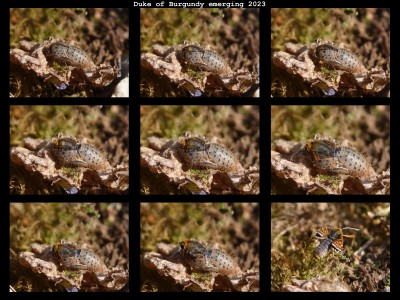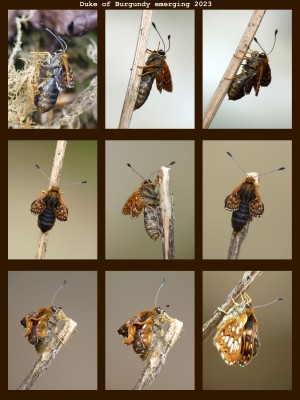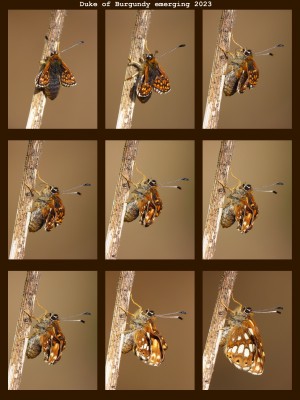There have been a number of constraints on me this season which have been outside of my control. These have significantly impacted the number of butterfly outings I have been able to enjoy and severely restricted my time at venues. As a result I was not able to spend as much time as I would have liked with my favourite group, the Hairstreaks, the exception being the Brown Hairstreak. Travelling outside my local area meant my time at the venue was sometimes reduced to just 20-30 mins making finding the butterfly somewhat challenging. This was not always helped by the behaviour of other enthusiasts.
One of my first outings was to see the Black Hairstreak and I had allowed myself the full 30 mins. It was not difficult to see the butterflies but the minutes were ticking by as I searched for one within reach of my camera. At last I succeeded even though it was quite high up. The footpath I was on was narrow and as I lined myself up for the shot I heard a voice beside me saying ‘excuse me’. I felt sure that this person would see what I was trying to do and give me a few seconds ………..but no!!!! I felt hands on my shoulders and I was physically moved out of the way before I could take the photo. Why would an experienced butterfly enthusiast do that???????? As a result this was the best I could find before it was time to leave.
I read that the WLH were having a good year so I visited a couple of local sites where many (mostly males) were seen but never down low and so yet again, my only shot was of an individual in a tree. I didn’t have the time to wait or the opportunity to return.
More recently I have been able to make some repeated visits to Brown Hairstreak sites and have been able to enjoy watching several females egg-laying.
After a failed attempt a couple of years ago I was at last successful in rearing the Duke of Burgundy and was able to return the butterflies to Noar Hill. It has been both educational and a delight to rear these insects and just as a reminder I shall include a note to myself of the things I discovered along the way:
Rearing the Duke of Burgundy has been a fascinating and insightful experience. It has been a challenge recording every individual transition but I wanted to get a complete and detailed understanding of the lives of these insects.
1. Eating shed skin but only in first instar.
It would seem that this is the first time that this has ever been recorded. I photographed this occurrence several times to ensure that it wasn’t just a one-off.
2. Colour changes prior to shedding skin
I was initially alarmed at the dramatic colour changes of each instar as they prepared to shed their skin but they were very consistent in that the colour drained from them for 3 days prior to the event leaving them looking very pallid. The day before a remarkable colour change came about as they turned an almost jet black. At this point the shedding of skin would happen within hours.
3. Length of time for transition from one instar to the next
Given that this took between 3-4 days (mostly 4 days) I have to wonder if the colour change and transition time is linked. The larva is obviously very vulnerable during these 3-4 days lying quite torpid on the underside of a leaf or stem of the food plant. The first time I witnessed this I thought that the larva had died. It looked dead – black and shrivelled. Likewise, when white it looked very insipid. I believe that this may be a survival mechanism to avoid predation whilst spending such a long period of time in this state. Over the life cycle of an immature stage that accounts for approximately 16 days or about 25%.
4. Difference in development times of individuals in identical conditions
Even allowing for the difference in timings of when the eggs were laid it was clear from the beginning that even as early as 1st instar the development of some individuals was much faster than others despite being kept in identical conditions. This difference appeared to widen as development progressed through the instars and I am still waiting for the last larva to pupate (although that looks imminent). Like the transition from one instar to the next, the 4th instar settles down close to the plant for about 3 days before actually pupating.
5. Behavioural changes between early and late instars
a. Mobility
In 1st and 2nd instar the larva do not stray far, mostly staying on the same leaf as where they hatched from the egg. This is also apparent in the wild, these being the easiest instars to track for that very reason. It is easy to locate them in the wild as at this stage they pepper the leaf with little holes where they have fed. They also seem unconcerned by gentle interference and monitoring. Conversely, 3rd and 4th instar roam much wider and their increased appetites leave their leaf in a skeleton form in very few hours. This increase in food intake may explain their increased mobility.
b. Camouflage
Their inclination to roam is not the only factor which causes difficulty in tracking and monitoring. Like many insects they become masters of camouflage and the slightest interference causes them to fall to the ground, similar to many other species. For the first time ever this year I have been able to find 3rd and 4th instars in the wild and this is wholly as a result of the rearing experience.



Yet another surprise this season – the sheer numbers of butterflies in the garden, including those egg-laying Large Skippers. This was a huge compensation for not being able to get very far. I was about to write that I tried really hard to make the most of it but the reality was, I just sat back with a coffee or glass of wine and enjoyed it!!!!!!
I only put the moth trap out once this season simply because I would not have had time in the mornings to deal with it. However, I was not disappointed although most of these moths are those I have come across whilst out and about. Whilst trying to find out a bit more about the Dingy Skipper on Bramshott Common I also watched this Burnet Companion moth being mated multiple times by different males. I am still unclear as to whether this is relatively common with moths.
Obviously another (recent) highlight for me was watching the HBHM lay many eggs and then attempting to rear 2 of them. It is still very much a mystery what happened to the second larva; its disappearance was such a disappointment but I was happy to watch the development and emergence of the remaining larva.
Rearing is another activity I haven’t had time to pursue as much as I would have liked this season but my interest in the immature stages has not diminished and I have tried to record them, along with other species of insects, as and when I came across them:
Like others I’m sure, I often encounter various other types of wildlife in my search for butterflies and this is something which I always appreciate. It is a pleasure and a privilege to get close to these creatures:
I don’t really think of myself as a photographer. For a start I don’t know enough about photography and for me, my camera is just a tool to capture memories. Having said that, I want the best image I can get and get frustrated with myself if I feel I could have done better. A few random shots below which I think are probably OK:
I like to continue to learn – do new things, go to different places, have fresh experiences – hence the interest in butterfly behaviour and in seeing something a little different. This year I haven’t had the luxury of spending too much time watching a single butterfly but seemed to stumble across a fair few mating pairs of various species:
I had hoped to finish my diary with a 2023 image of a Clouded Yellow but despite recent efforts I have not seen one all season. I can’t really complain after witnessing that amazing spectacle last year of hundreds of these attractive butterflies together in one field. A once in a lifetime event I guess so instead I shall end with a few shots from then:
…….and I know I do this every year but I can’t resist recording the beauty of their wings.
Hope you can all squeeze the most out of the rest of the season as it would seem that there may be yet more to come depending on the weather.